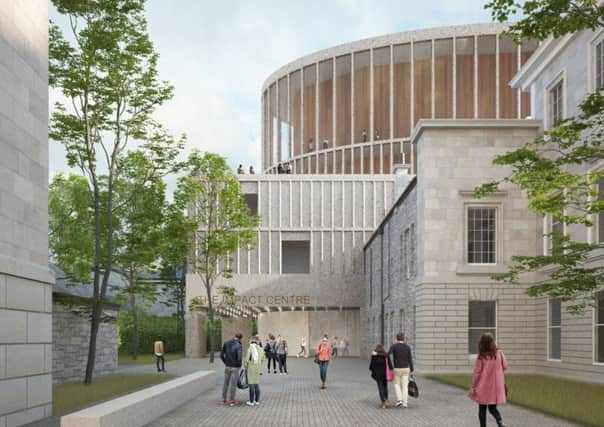John McLellan: Edinburgh's concert hall '˜gift horse' gets teeth checked


It was supposed to be a gift horse whose teeth would go unexamined, but despite the expectations of its influential backers it doesn’t appear to be working out that way for Edinburgh’s new concert hall.
Set to rise up behind the Royal Bank of Scotland’s Georgian mansion, Dundas House on St Andrew Square, the 1,000-seater Impact Centre was included in the £1.2m Edinburgh ‘City Region Deal’ and so has both Scottish and UK Government support to the tune of £25m out of a total expected cost of £45m.
Advertisement
Hide AdLed by Sir Euan Brown and designed by Sir David Chipperfield, the centre will replace the Queen’s Hall as the Scottish Chamber Orchestra’s base and has financial backing from International Festival benefactor Carol Grigor and her Dunard Fund. Dunard is also bank-rolling opposition to the hotel plan for the old Royal High School and is at the heart of the scheme to turn it into a new home for the St Mary’s Music School, also with a public performance hall.
Sold as a key component in securing the Edinburgh Festival’s place at the top of the global cultural league, and with an internationally renowned architect on board, Impact’s well-connected team might not have expected to encounter much resistance, but this week The Scotsman revealed the Architectural Heritage Society of Scotland had lodged an objection because the new building will “tower above” Dundas House. “The proposal is too large and too tall for such a restricted plot ... and as such represents an overdevelopment of the site,” said the AHSS submission to the city council.
If this is bad news for Impact, it’s good news for the new St James Centre whose developer, TH Real Estate (THRE), has been making a similar point for some months, arguing that the height of the hall will steal the view of St Andrew Square and George Street which their hotel was expecting to enjoy and was part of the design brief.
THRE is also unhappy that large equipment trucks could access the concert hall through the currently pedestrianised Multrees Walk, something which was actually supported by the Edinburgh Design Panel when it met to discuss Impact last year. The alternative, for THRE to provide access through the St James Centre’s underground services entrance, received a predictably cool reception.
It now appears that behind-the-scenes negotiations have failed, with St James development chief Martin Perry writing a letter to locals urging them to object. In turn, Impact is now said to be consulting its lawyers about its contents. “It is not proper for their letter to include inaccuracies which may mislead others,” Impact chair, Sir Euan Brown, told The Times. “This is extremely disappointing and we are taking appropriate action.”
What those inaccuracies are is unclear, although it’s hard for THRE to argue about the adverse effect of the concert hall’s height on the city skyline when there will be no more dramatic alteration than the golden ribbon/walnut whip/turd design of the hotel at the heart of St James. But Impact faces its own challenge in arguing that such a massive construction, largely in concrete, is compatible with the surroundings when it has taken over a decade to get rid of the concrete monstrosity which was St Andrew’s House.
Advertisement
Hide AdThe Cockburn Association, so often at the heart of opposition to contemporary construction in the World Heritage site, has given its blessing and that means much hangs on the position of Historic Environment Scotland and the World Heritage Trust, whose director Adam Wilkinson has been keeping his head lower down on this issue than his prominent opposition to the Royal High School hotel scheme.
At least the AHSS is being consistent in its opposition to both the Royal High hotel and the concert hall, because it’s not difficult to argue that the, well, ‘impact’ on the main High School building and Dundas House from the proposed modern additions is similar.
Advertisement
Hide AdIt might be left to the members of the city council’s planning committee, of which I’m one, to decide what happens. As it stands, my mind is entirely open.
Before that, this Wednesday my planning colleagues and I must decide whether to grant permission to the Gleneagles club and hotel proposal for the grand old Bank of Scotland office next door to Dundas House. Which means I can’t say anything about it.
Who will empty my bin?
With some understatement, Edinburgh council’s head of place management, Gareth Barwell, informed councillors this week that changes to the council’s waste service “had been disruptive for many residents”. Those residents who still wonder when their bins will be emptied, as opposed to what it says in the council’s recent letter, might read “disruptive” as “utterly shambolic”. As for the new garden waste system which now costs £25 a bin, mine is still outside on the street.
SNP-Labour coalition rift deepens by the day Amidst the chaos, the rift between some Labour councillors and the SNP on Edinburgh council’s coalition administration is becoming deeper by the day, and is being played out publicly through the letters page of the Evening News. Now Cllrs Scott Arthur and Gordon Munro have not only accused colleagues of failing to speak up about Scottish Government funding cuts, but of interpreting opposition to education cuts as open attacks.
Tellingly, they quote the council partnership agreement which requires the administration to lobby the Scottish Government to ensure adequate funding for local services and contrast the current leadership’s silence with ex-SNP leader Sandy Howat’s public criticism.
This week they and their Labour colleagues face a further dilemma over a Conservative motion to examine options for suspending Primary One testing. Opposition puts them at odds with the national party so for once in this council, the local leadership might actually have to stand up for themselves and publicly reject SNP policy.